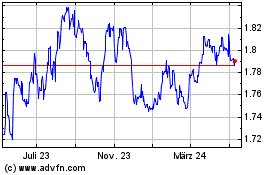Antipodean Currencies Fall Amid Risk Aversion
26 Oktober 2023 - 5:29AM
RTTF2
Antipodean currencies such as the Australia and the New Zealand
dollars weakened against their major currencies in the Asian
session on Thursday, amid disappointing earnings reports, a surge
in Treasury yields, concerns about interest rates and the outlook
for economic growth. Worries about the conflict in the Middle East
amidst reports of an imminent ground invasion of Gaza by Israel
also weighed on the markets.
Traders also looked ahead to key U.S. economic data in the
coming days, including a preliminary reading on third quarter GDP
on Thursday and personal income on Friday.
In the Asian trading today, the Australian dollar fell to more
than a 1-year low of 0.6270 against the U.S. dollar and nearly a
2-week low of 94.25 against the yen, from yesterday's closing
quotes of 0.6295 and 94.47, respectively. If the aussie extends its
downtrend, it is likely to find support around 0.60 against the
greenback and 92.00 against the yen.
Against the euro and the Canadian dollar, the aussie dropped to
a 2-day low of 1.6824 and a 3-day low of 0.8664 from Wednesday's
closing quotes of 1.6787 and 0.8687, respectively. The aussie may
test support around 1.70 against the euro and 0.84 against the
loonie.
The aussie edged down to 1.0856 against the NZ dollar, from
yesterday's closing value of 1.0868. On the downside, 1.07 is seen
as the next support level for the aussie.
The NZ dollar fell to nearly a 1-year low of 0.5774 against the
U.S. dollar, from yesterday's closing value of 0.5792. The next
possible downside target for the aussie is seen around the 0.55
region.
Against the euro and the yen, the kiwi dropped to nearly a
2-month low of 1.8267 and nearly a 1-1/2-month low of 86.78 from
Wednesday's closing quotes of 1.8243 and 86.94, respectively. If
the kiwi extends its downtrend, it is likely to find support around
1.85 against the euro and 84.00 against the yen.
Meanwhile, the safe-haven currency, the U.S. dollar,
strengthened against its major counterparts in the Asian session as
Asian shares traded lower.
The U.S. dollar rose to more than a 1-year high of 150.51
against the yen and more than a 3-week high of 1.2076 against the
pound, from yesterday's closing quotes of 150.10 and 1.2103,
respectively. If the greenback extends its uptrend, it is likely to
find resistance around 152.00 against the yen and 1.19 against the
pound.
Against the euro and the Swiss franc, the greenback advanced to
1-week highs of 1.0541 and 0.8987 from Wednesday's closing quotes
of 1.0566 and 0.8967, respectively. The greenback may test
resistance around 1.04 against the euro and 0.92 against the
franc.
The greenback climbed to more than a 7-month high of 1.3819
against the Canadian dollar, from yesterday's closing value of
1.3804. On the downside, 1.39 is seen as the next resistance level
for the greenback.
Looking ahead, the Confederation of British Industry releases
monthly Distributive Trades survey results at 6:00 am ET in the
European session.
At 8:15 am ET, the European Central Bank is set to publish its
monetary policy decision. The ECB is widely expected to keep its
interest rates unchanged and also to retain its hawkish bias.
Following the announcement of monetary policy decision, ECB
President Christine Lagarde holds press conference in Athens,
Greece.
In the New York session, U.S. durable goods orders for
September, U.S. flash GDP growth rate for the third quarter and
U.S. weekly jobless claims, U.S. pending home sales for September,
U.S. Kansas Fed manufacturing index for October, U.S. wholesale
inventories for September and Canada average weekly earnings report
for August and manufacturing sales data for September, are slated
for release.
At 9:00 am ET, Federal Reserve Board Governor Christopher Waller
will give opening remarks before the Economics of Payments XII
Conference, in Washington, U.S.
Euro vs NZD (FX:EURNZD)
Forex Chart
Von Jun 2024 bis Jul 2024

Euro vs NZD (FX:EURNZD)
Forex Chart
Von Jul 2023 bis Jul 2024
